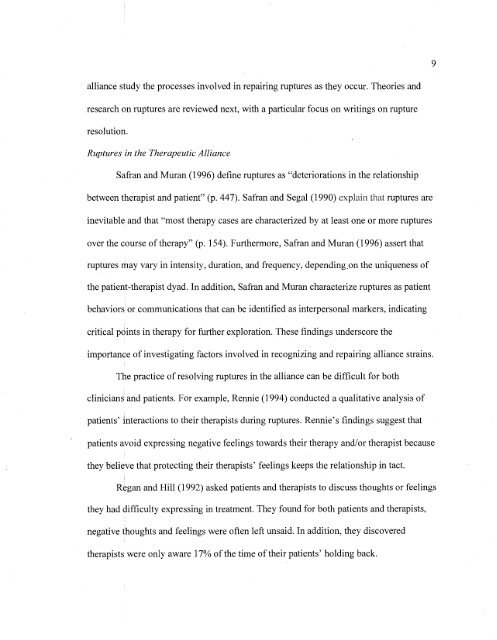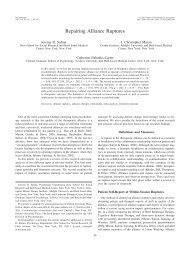Download - The Safran Lab
Download - The Safran Lab
Download - The Safran Lab
You also want an ePaper? Increase the reach of your titles
YUMPU automatically turns print PDFs into web optimized ePapers that Google loves.
alliance study the processes involved in repairing ruptures as they occur. <strong>The</strong>ories and<br />
research on ruptures are reviewed next, with a particular focus on writings on rupture<br />
resolution.<br />
Ruptures in the <strong>The</strong>rapeutic Alliance<br />
<strong>Safran</strong> and Muran (1996) define ruptures as "deteriorations in the relationship<br />
between therapist and patient" (p. 447). <strong>Safran</strong> and Segal (1990) explain that ruptures are<br />
inevitable and that "most therapy cases are characterized by at least one or more ruptures<br />
over the course of therapy" (p. 154). Furthermore, <strong>Safran</strong> and Muran (1996) assert that<br />
ruptures may vary in intensity, duration, and frequency, depending.on the uniqueness of<br />
the patient-therapist dyad. In addition, <strong>Safran</strong> and Muran characterize ruptures as patient<br />
behaviors or communications that can be identified as interpersonal markers, indicating<br />
critical points in therapy for further exploration. <strong>The</strong>se findings underscore the<br />
importance of investigating factors involved in recognizing and repairing alliance strains.<br />
<strong>The</strong> practice of resolving ruptures in the alliance can be difficult for both<br />
clinicians and patients. For example, Rennie (1994) conducted a qualitative analysis of<br />
patients' interactions to their therapists during ruptures. Rennie's findings suggest that<br />
patients avoid expressing negative feelings towards their therapy and/or therapist because<br />
they believe that protecting their therapists' feelings keeps the relationship in tact.<br />
Regan and Hill (1992) asked patients and therapists to discuss thoughts or feelings<br />
they had difficulty expressing in treatment. <strong>The</strong>y found for both patients and therapists,<br />
negative thoughts and feelings were often left unsaid. In addition, they discovered<br />
therapists were only aware 17% of the time of their patients' holding back.



